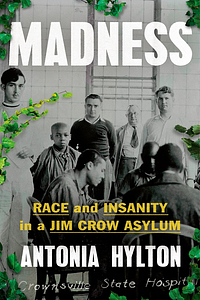Take a photo of a barcode or cover
dark
emotional
informative
inspiring
reflective
slow-paced
emotional
informative
sad
fast-paced
hopeful
informative
inspiring
reflective
sad
medium-paced
dark
emotional
informative
medium-paced
challenging
dark
emotional
informative
reflective
medium-paced
challenging
emotional
informative
Quotations:
"Crownsville’s origin would establish patterns that would haunt the asylum for its 93 years in operation. Early records and photos of Crownsville’s founding led Hylton to question America’s legacy of race and mental health. What does it mean to be healthy and well enough to clear the wood, build a road, and construct a hospital, yet also be so sick you require institutionalization? How do we decide who is irredeemable and who is capable of recovery? What role have men like Robert Winteroad played in alienating Black patients from therapy and care? Crownsville positioned itself as the answer to “negro insanity,” with little interest, at least in the public record, in exploring why Black people were suffering in the first place.
To put it simply, Black Americans refused to quiet their pain or live as second-class citizens any longer. The backlash was swift, and American urban space became criminalized to a sweeping extent. Behaviors that had once associated with poverty and illness because part of a growing list of crimes that could land you in jail. A new preoccupation with crime not only expanded its definition but also reconfigured crime fighting methods. In 1965 new federal commitments to fighting crime allowed local law enforcement to receive an influx of funds and equipment if they could show that crime was rising. In 1968 the Supreme Court decided Terri v Ohio, a landmark ruling that found it was constitutional for police to stop and frisk a person they reasonably expected to involved in a crime. The ruling made it easier for law officials to act on suspicion and probable cause.
As many historians have reasonable argued rising hostility towards Black protest and criminality fostered much of this new enthusiasm for expansive policing initiatives, and those initiatives were often narrowly aimed at America’s Black citizens. Just as the neighbors of Maryland’s Crownsville hospital had feared Black patients’ escape and riots to a degree that was disproportionate to their actual occurrence in the asylum system, so too did the white American electorate grossly overestimate the threat of Black crime. When there were riots they very rarely came to white neighborhoods. Very few rioters attacked white people, and most of the causalities were caused by the police, not Black people protesting for social change. Meanwhile, police were arresting peaceful protesters for bus boycotts, or sit-ins. Politicians like Governor George Wallace of Alabama, the man who authorized state troopers to beat and detain protestors, famously reached office by amplifying the racial anxiety of white voters. Wallace admitted that his political career took off after he focused on citizens’ fear of Black people instead of infrastructural improvements to the state. “You know I tried to talk about good roads and good schools and all these things that have been a part of my career, and no body listened. And then I began talking about n* and they stomped the floor.
The civil rights movement made criminality a disproportionately relevant issue, setting in motion a pattern of events that stretched the definition of criminal behavior and strengthened every part of the carceral apparatus, asylums included.
The crises of mental illness, housing insecurity, and income inequality, bear down on all of us. there will be more Jordan Nealy’s, who come into public view and refuse to be quiet about the humiliations they’ve endured. We can try and construct cities and communities where these embarrassments remain out of view, where we keep up this lie that we are separate and unscathed. But it is only going to get harder. There are too many people who know the truth. There are too many families with loved ones who may call out for help in the future."
"Crownsville’s origin would establish patterns that would haunt the asylum for its 93 years in operation. Early records and photos of Crownsville’s founding led Hylton to question America’s legacy of race and mental health. What does it mean to be healthy and well enough to clear the wood, build a road, and construct a hospital, yet also be so sick you require institutionalization? How do we decide who is irredeemable and who is capable of recovery? What role have men like Robert Winteroad played in alienating Black patients from therapy and care? Crownsville positioned itself as the answer to “negro insanity,” with little interest, at least in the public record, in exploring why Black people were suffering in the first place.
To put it simply, Black Americans refused to quiet their pain or live as second-class citizens any longer. The backlash was swift, and American urban space became criminalized to a sweeping extent. Behaviors that had once associated with poverty and illness because part of a growing list of crimes that could land you in jail. A new preoccupation with crime not only expanded its definition but also reconfigured crime fighting methods. In 1965 new federal commitments to fighting crime allowed local law enforcement to receive an influx of funds and equipment if they could show that crime was rising. In 1968 the Supreme Court decided Terri v Ohio, a landmark ruling that found it was constitutional for police to stop and frisk a person they reasonably expected to involved in a crime. The ruling made it easier for law officials to act on suspicion and probable cause.
As many historians have reasonable argued rising hostility towards Black protest and criminality fostered much of this new enthusiasm for expansive policing initiatives, and those initiatives were often narrowly aimed at America’s Black citizens. Just as the neighbors of Maryland’s Crownsville hospital had feared Black patients’ escape and riots to a degree that was disproportionate to their actual occurrence in the asylum system, so too did the white American electorate grossly overestimate the threat of Black crime. When there were riots they very rarely came to white neighborhoods. Very few rioters attacked white people, and most of the causalities were caused by the police, not Black people protesting for social change. Meanwhile, police were arresting peaceful protesters for bus boycotts, or sit-ins. Politicians like Governor George Wallace of Alabama, the man who authorized state troopers to beat and detain protestors, famously reached office by amplifying the racial anxiety of white voters. Wallace admitted that his political career took off after he focused on citizens’ fear of Black people instead of infrastructural improvements to the state. “You know I tried to talk about good roads and good schools and all these things that have been a part of my career, and no body listened. And then I began talking about n* and they stomped the floor.
The civil rights movement made criminality a disproportionately relevant issue, setting in motion a pattern of events that stretched the definition of criminal behavior and strengthened every part of the carceral apparatus, asylums included.
The crises of mental illness, housing insecurity, and income inequality, bear down on all of us. there will be more Jordan Nealy’s, who come into public view and refuse to be quiet about the humiliations they’ve endured. We can try and construct cities and communities where these embarrassments remain out of view, where we keep up this lie that we are separate and unscathed. But it is only going to get harder. There are too many people who know the truth. There are too many families with loved ones who may call out for help in the future."
emotional
informative
sad
medium-paced
informative
sad
medium-paced
I have read a lot of books about the Black experience in America, so none of the information provided in this book about the treatment of mentally ill Black folks were treated in our country’s history. Still, I am horrified over these stories. Antonia Hylton has devoted her life’s work to researching Crownsville and its history, through the lens of a person of color and one who has experience mental illness in her own family. A must-read for people who wish to learn from history and advocate for better for us all.
dark
emotional
informative
sad
medium-paced





